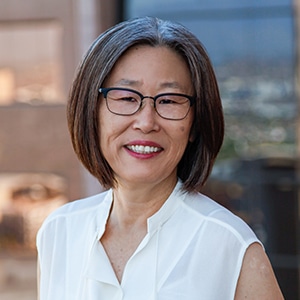

Creating health care equity in Greater Phoenix
Published: 03/09/2023
Updated: 03/16/2023
Kathleen Lee provides insights on NSF grants, healthtech and the importance of health care equity
by Kathleen Lee
Tell us about yourself:
As SVP of Regional Initiatives, my role at GPEC is to focus on advancing regional competitiveness. To do my job, I collaborate and coordinate with public and private sector partners to leverage our key strengths and assets for future opportunities. This involves developing cluster strategies, policies, and the institutional capacity for attracting new investments and growing businesses in the region.
I am also focused on learning from and contributing to evolving economic development practice through our engagement with local and national groups. This is one of the most rewarding and exciting aspects of my work. I am constantly learning and experimenting with partners on innovative solutions.
What is health inequity and why are you passionate about driving solutions in this space?
Foremost, disparity in access to quality health care affects people’s health and wellbeing. It also has significant economic and societal consequences, including unnecessary cost to health systems, reduction in economic productivity, and underutilization of human potential to create innovative solutions that benefit all of society.
Deloitte estimated that health inequities account for approximately $320 billion in annual health care spending in the U.S. and it could grow to $1 trillion or more by 2040. I believe as a society we value basic human needs such as access to education, health care, and housing.
What is the NSF grant and which community partners have been involved in the proposal process?
The Regional Innovation Engines program is a new program and priority for the NSF Technology, Innovation and Partnership (TIP) Directorate. The Engines program intends to catalyze and accelerate regional-scale, R&D based innovation ecosystems throughout the U.S., especially in geographies with nascent and emerging ecosystems.
NSF plans to support about five regional engines across the country that address significant societal challenges with a grant of up to $160M over 10 years. The GPEC-led proposal, “Continuous Advancement of Health through Research, Technology and Talent (CHARTT),” is a product of collaboration between Arizona State University, University of Arizona, Maricopa Community Colleges, Arizona Western College, Yuma Regional Medical Center, RPM-One, Big Little Sensor Company, and HonorHealth.
In addition to these core partners who will execute the core functions of the engine – research and development, commercialization, and workforce education and training - the CHARTT proposal includes other strategic partners who will provide resources, expertise, and collaborative partnerships. These initial strategic partners include the AZ Venture Development Corporation, Contexture, Tohono O’odham Community College, Flinn Foundation, and Partnership for Economic Innovation. In addition, health care, education and technology leaders will serve on the board of directors.
Explain the difference between the CHARTT and ARHC elements of the proposal:
CHARTT proposal focuses on R&D and workforce development to accelerate novel technologies move through the bench to market process. The GPEC-led EDA proposal focused on building infrastructure such as incubators, manufacturing and entrepreneurial support programs.
How will Greater Phoenix benefit from receiving the NSF grant?
The NSF grant and 10-year partnership with NSF is an opportunity to accelerate the development and commercialization of novel technologies that will expand health care access to underserved areas and populations in Arizona. These activities will also attract new investments to disadvantaged communities, creating quality jobs and entrepreneurship opportunities.
What is GPEC’s involvement with the NSF grant proposal?
GPEC serves as the lead organization responsible for establishing the convening, governance, and grant administration infrastructure for CHARTT. GPEC will support core partners and engage with stakeholders to achieve CHARTT’s mission.
What are some advancements in healthtech within the region that you are excited about right now?
One of the most exciting trends in health care is the utilization of sensors, wearable and other digital technologies. These technologies have the potential to transform delivery of care, from diagnostics to treatment, and expand access to quality care in remote areas and underserved communities.
Sophisticated, yet simple to operate, devices and systems with applications in chronic health conditions such as mobility issues, neurological disabilities, diabetes, and obesity are currently being developed at the university laboratories and research centers in Arizona. These research efforts leverage recent maturity in high-performance computing, artificial intelligence (AI)/machine learning, data interoperability, advanced biosensors, battery technologies, virtual reality (VR)/augmented reality (AR), and other disciplines.
Which local organizations or companies should we know about in the health care and healthtech sectors?
Global medical technology and life sciences companies in Greater Phoenix include Medtronic, BD, Dexcom, GlobalMed and others. We are also seeing growth of bioscience, med-tech and digital health startups, which include more than 230, according to recent count by Tracxn. These startups include Solera, CND Life Sciences, ReSuture, RPM-One, Neolight, Advinow, Anuncia Medical, and others.
In addition, our nationally recognized research and clinical research organizations including Translational Genomics Research Institute (TGen), ASU Biodesign Institute, Barrow Neurological Institute, and Banner Alzheimer's Institute are attracting federal and private investments and generating new technologies that advance health.
How can the community get involved to improve and promote health equity?
Promoting health equity is about addressing, removing, and eliminating social, economic, cultural, and physical barriers that exist across multiple systems. Our economic development partners can work strategically with various community development professionals within their internal municipal teams as well as support and collaborate with community-based organizations, industry, and workforce and education providers.
Creating healthy communities requires efforts that bring together resources to enhance environmental sustainability, access to quality jobs and investment, affordable housing, open space, and other critical programs.
Meet the Author
Kathleen Lee
Senior Vice President, Regional Initiatives
Greater Phoenix Economic Council
